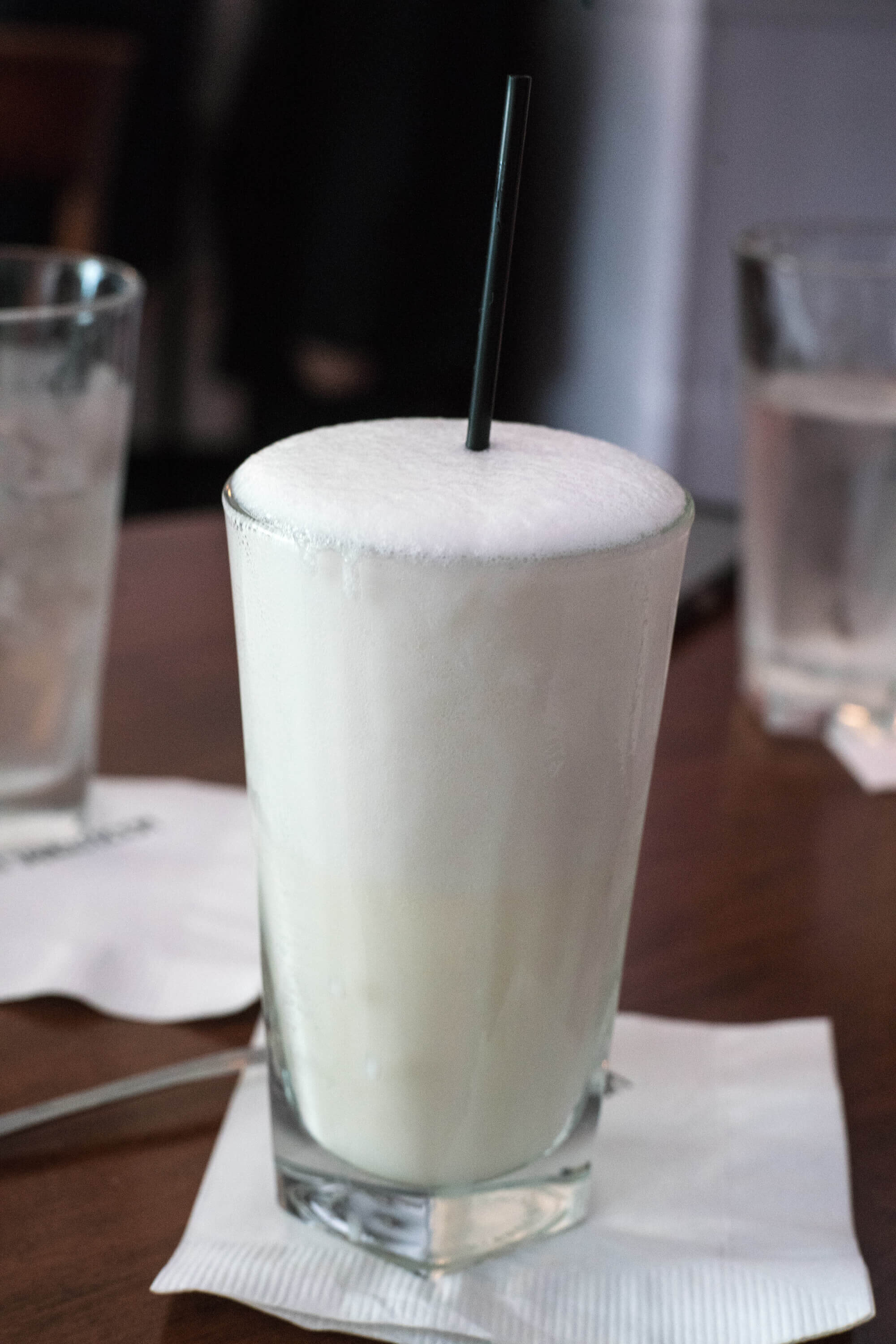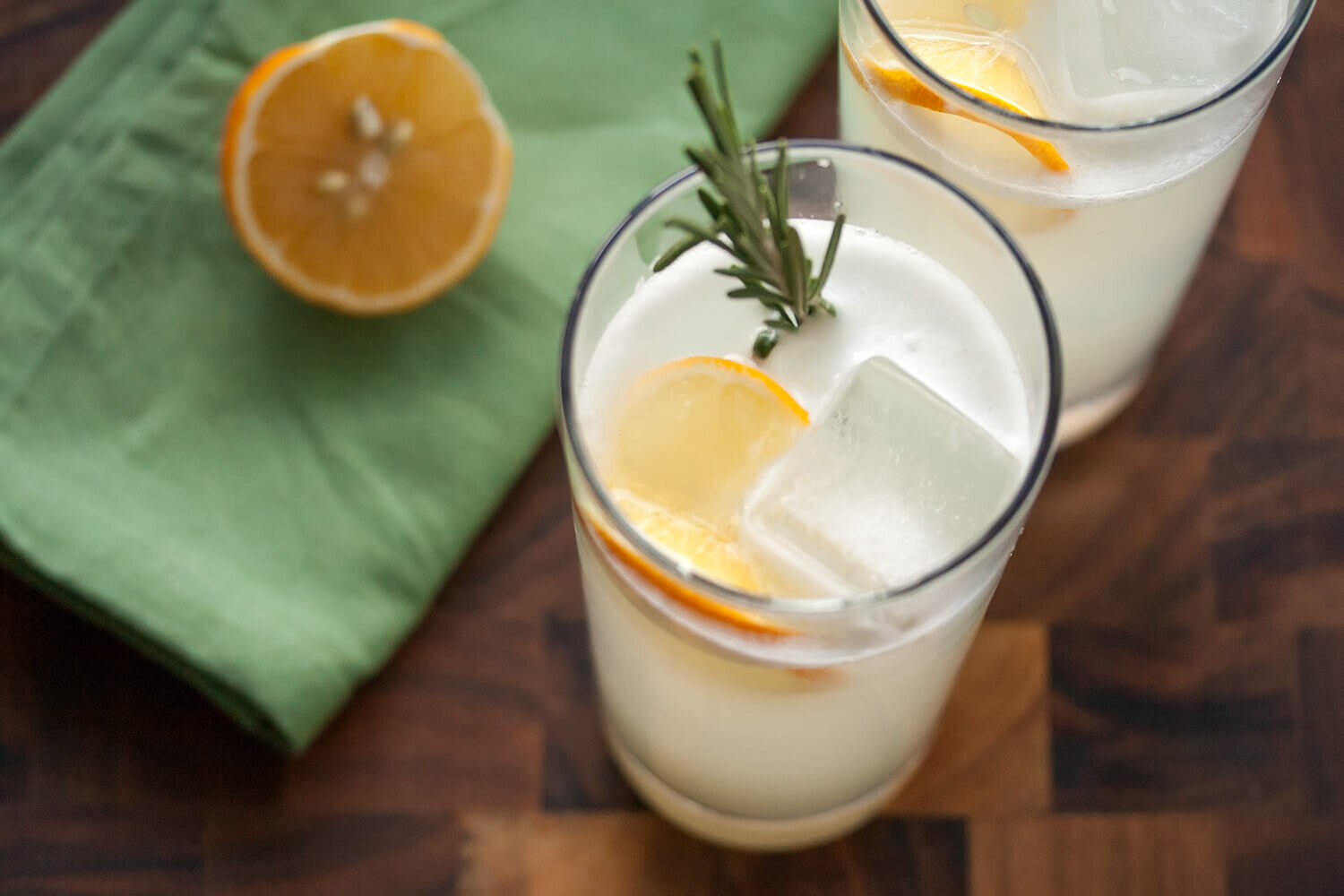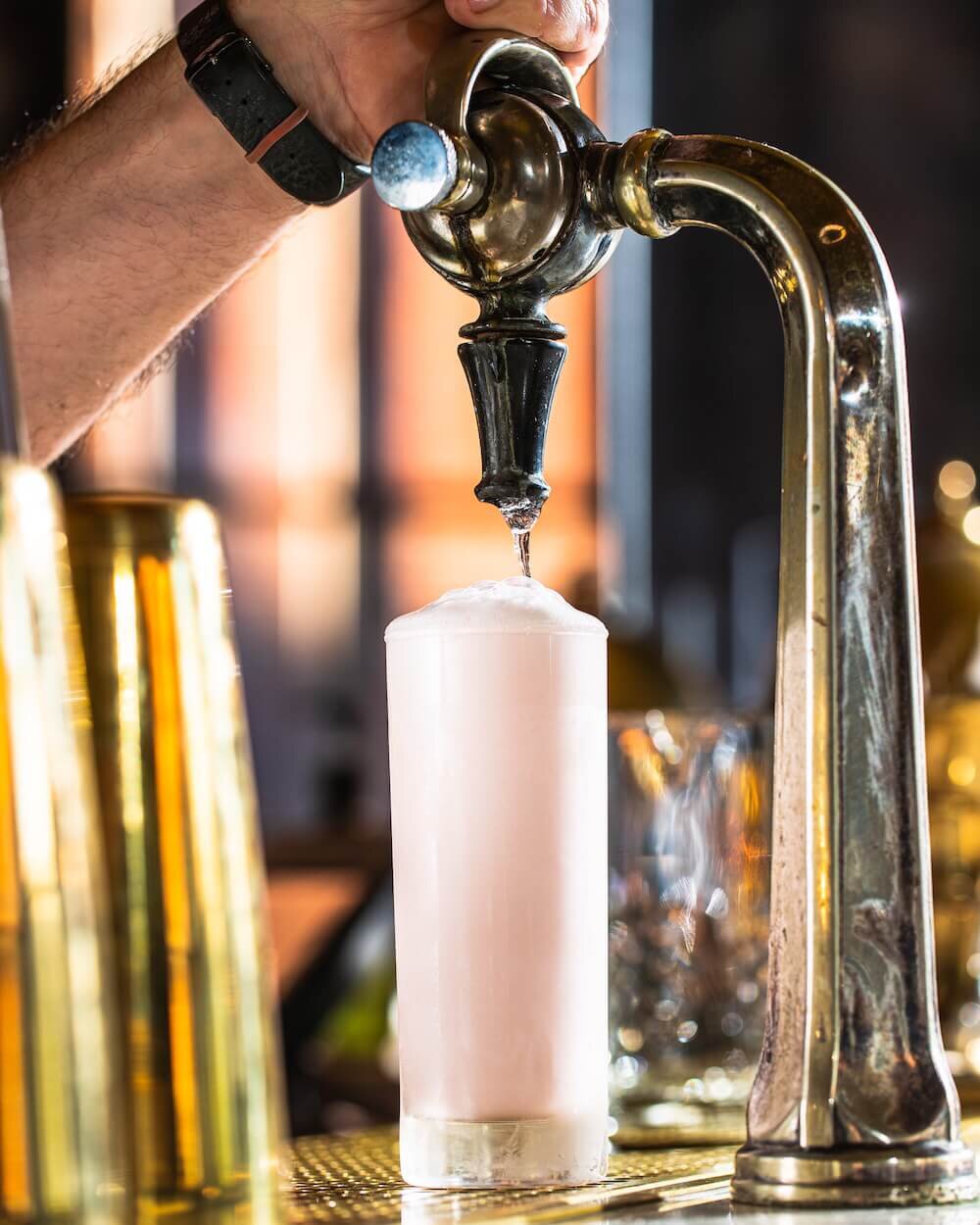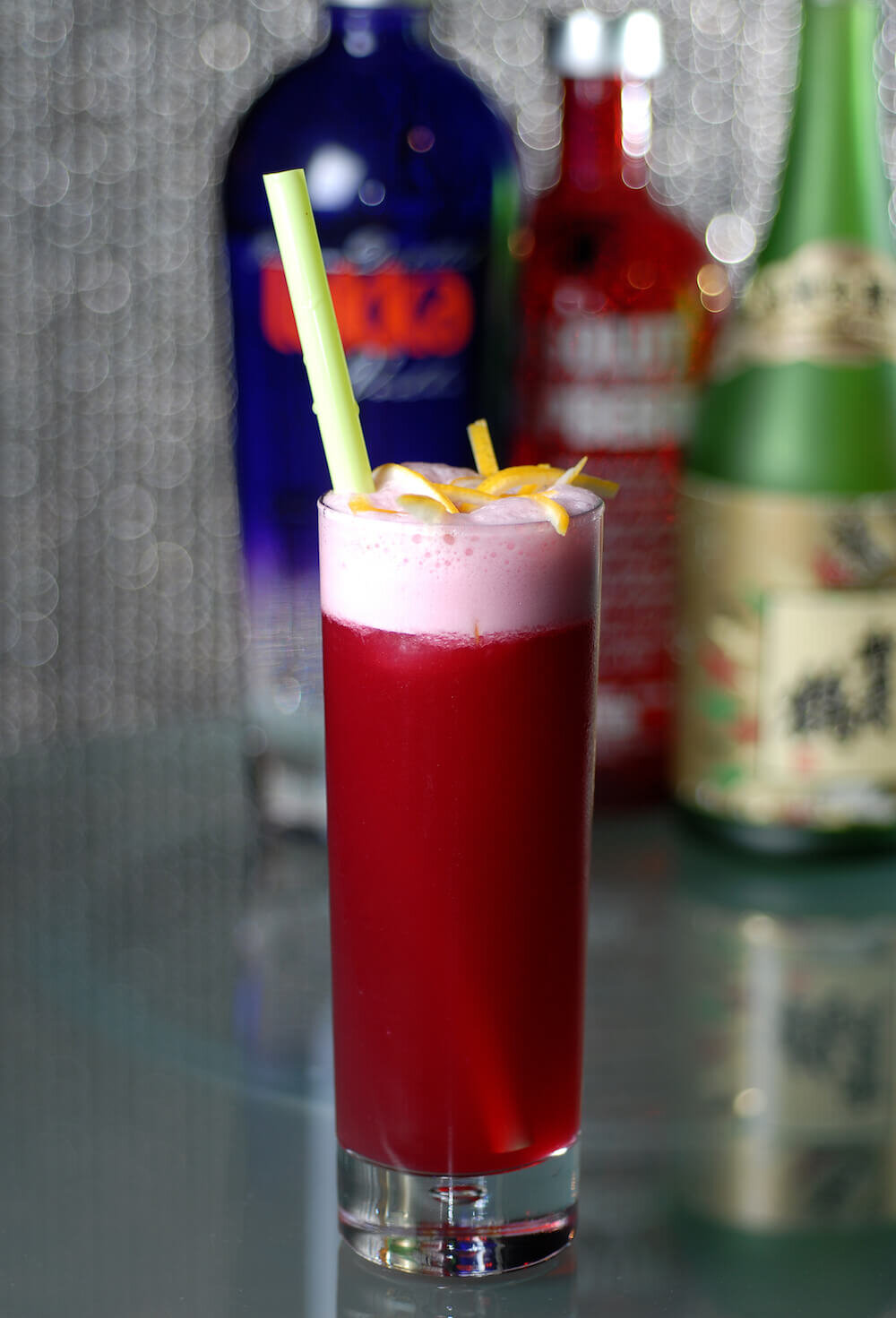Everything You Need to Know about the Ramos Gin Fizz & the Best Variations
"VTR - Ramos Gin Fizz" by Edsel L is licensed under CC BY-SA 2.0
The Ramos Gin Fizz is a thing of beauty. It’s boozy without being strong, faintly sweet without being cloying, frothy without being heavy (or too much like a milkshake). It’s bright and floral but also soothing. Because the drink includes a few drops of either rose water or orange blossom water, many writers have compared enjoying a Ramos fizz to drinking a flower. But to my mind, when made with just the right combination of ingredients—preferably (for this drinker) a combination of lemon juice and orange blossom water—it tastes like being in California.
Because the Ramos fizz contains both an egg and a bit of cream and is relatively light on alcohol (compared to other classic cocktails), it is usually served at brunch. But its parent, the classic fizz, lends itself to any time of day. The structure of a fizz is essentially the same as a Collins, but shaken, which produces a frothy, cloudlike top. But the egg white can also make the drink seem daunting—not only because the egg is raw, but because it requires a lot of shaking.
History of the Gin Fizz
According to cocktail historian Dave Wondrich, the gin fizz (or “fiz”) is an American adaptation of the popular gin punch served at hotels in London—a combination of gin, lemon juice, maraschino liquor, and chilled soda water that eventually became so associated with one particular waiter at Limmer’s Hotel that it was eventually named after him: the Collins. When the recipe migrated to the U.S. in the 1870s, bartenders began shaking the drink and, by the 1890s, adding an egg white to some variations. Eventually, the drink (both versions with and without the egg) became known as the fizz.
"Meyer Lemon Rosemary Gin Fizz" by Isabelle @ Crumb is licensed under CC BY-NC-ND 2.0
The Rise of the Ramos Gin Fizz
Once fizzes became popular, bartenders started making their own variations, including versions using whiskey, brandy, rum, and even absinthe. But the most revelatory, and popular, was the Ramos gin fizz, invented in New Orleans by Henry Charles Ramos. According to various accounts, Ramos first hired a dedicated “shaker” whose job was just to shake the wildly popular cocktail. Later, Ramos had a whole line of men who would shake the drink until their arms were tired, then pass it to the next person in line, who would shake some more. (“Shake and shake and shake until there is not a bubble left but the drink is smooth and snowy white…” Ramos once told a reporter.) All of this shaking—some recipes specify shaking for a total of twelve minutes, first “dry” and then with ice—emulsifies the combination of egg white and cream Ramos added to the drink and gives the cocktail a creamy, velvety texture.
Tony Abou-Ganim, “The Modern Mixologist” who designed the drinks menu at Libertine Social in Las Vegas learning to make the Ramos fizz while working for Jack Slick at the Balboa Café in San Francisco, one of the few places where you could find the drink in the 1980s. “I had never heard of the Ramos gin fizz, but it was on the brunch menu, and people came from all over to get them,” he says. “Jack once dumped a whole tray of them because they weren’t prepared to his liking, and made me make them all over again. And as anyone who has made a gin fizz knows, that is not an easy task.”
The Return of the Ramos
Despite the extra work the drink requires, the Ramos gin fizz (and other versions of the drink) became popular again with the reemergence of classic cocktail culture in the mid-aughts. And once again, a number of bartenders across the country started playing with the form and adding their own twists. “The gin fizz is an easy one because it’s such a classic formula,” says Lee Noble, the mixologist at Art in the Age, in Philadelphia. “It’s easy to drink and easy to riff on. With five ingredients, you have five options—subbing in a different style of gin, alternating citrus, sweetener, an egg white substitute, or even subbing in Champagne for the seltzer. Any slight change gives the drink a new character, so the changes don’t need to be drastic.”
The Ramos fizz is still arguably the most popular version of the drink. Many bartenders play with this classic by keeping the cocktail’s standard formula but adding additional flavor notes with syrups, additional liquors, or fresh fruit. Lee Noble adds a simple syrup made with calendula and a fresh flower garnish to his Flora Ramos. “I wanted to play up the floral aspect of the orange blossom water and keep it subtle, which the mild calendula allowed beautifully,” he explains.
Some swap out the gin altogether, for a different kind of fizz. The mixologists at ABV, in San Francisco, for instance, replace it with mezcal and a touch of dry Curaçao and augment the lime juice with grapefruit shrub. The result, Lefty’s Fizz, has become one of the bar’s signature drinks.
Riviera Fizz. Photo credits to Anthony DiBiase.
At Via Vecchia in Portland, Maine, beverage director Mark Hibbard uses a combination of green chartreuse, aquavit, bitter rosso, and galliano in his Riviera Fizz. “We try to showcase Italian Amari and aperitivos as much as possible,” he says. “Luxardo Bitter Rosso provides the familiar orange notes of a traditional gin fizz while giving the drink a slightly bitter backbone, and the Galliano adds subtle juniper and vanilla to the mix.”
Dark & Fizzy. Courtesy the Perfect Puree of Napa Valley
As non-alcoholic drinks become more sophisticated, some establishments are also making NA fizzes, which benefit from the drink’s inherent complexity and texture. At La Casa Cigars and Lounge at Tivoli Village in Las Vegas, Tim Rita, spokesperson for Perfect Puree of Napa Valley makes a Dark and Fizzy with non-alcoholic rum, passion fruit from Perfect Puree of Napa Valley, and calamansi juice. “I like to show that cocktails have no barriers,” he says.
Cherry Gin Ramos. Courtesy the Perfect Puree of Napa Valley
A few miles away, at Libertine Social, in the Mandalay Bay, the drinks menu developed by Tony Abou-Ganim has an entire section of fizzes, including versions made with vodka and others that replace the soda water with prosecco. (Abou-Ganim also likes to incorporate fresh fruit purees into a classic Ramos fizz) In addition to adding new flavors to the drink, Abou-Ganim also takes an unorthodox approach to shaking his fizzes: “We would have been out of business a long time ago if our bartenders were actually shaking fizzes for twelve minutes,” he says, noting that he probably only shakes the drinks for half that time or less. He also skips the step of shaking the drink dry, before adding ice. “If you’re using big, hard, dry ice cubes, you can achieve the same consistency without the extra step of dry shaking,” says Abou-Ganim. “A lot of people will debate me on that, but I think the key to it is the quality of the ice.” He also sometimes uses a stick blender to froth the ingredients, particularly when he has a large batch of drinks to make all at once.
Rules & Techniques
That said, Abou-Ganim cautions against changing the foundational ingredients of a Ramos fizz, like using milk in place of the heavy cream or opting for pasteurized egg whites. If you do, he says, the drink won’t have the same texture—no matter how long you shake it. He also believes that you should have a mix of lemon and lime juices to get the right acidity, and he prefers powdered sugar to simple syrup because he feels it gives the drink a slightly better texture. Lastly, he notes that even if cut back on the shaking time, you still need to make any Ramos-inspired fizzes slowly, and with care. “It’s not a drink you can rush,” he says. “Even when you pour it into the glass, you have to let it settle for a minute before you add the cold soda water to bring it to life.”
Flora Fizz
Flora_Ramos. Photo credits to Quaker City Mercantile
2 oz Tamworth White Mountain Gin
¾ oz calendula syrup (recipe below)
½ oz lemon juice
½ oz lime juice
½ oz heavy cream
3 dashes orange blossom water
1 egg white
Top with Seltzer
Calendula Syrup
Bring 1 cup of water to a boil in a small saucepan on the stove. Add 1 cup of calendula blossoms, turn off the burner, and cover the pot. Allow the flowers to steep for 10 minutes. When ready, strain the blossoms off the liquid carefully. Be sure to press out any liquid from the blossoms they had absorbed and add it back into to your bulk calendula liquid. Put the liquid back in the pot and return it to the stove. Set the heat to medium and whisk in 1 cup of sugar until dissolved. Remove from heat and allow to cool before using.
Milano (h3)
1 ½ oz Effen Blood Orange vodka
¾ oz Aperol
1 oz fresh lemon juice
1/2 oz simple syrup
1 tablespoon egg white
Chilled Prosecco
Add all ingredients other than the Prosecco to a mixing glass; shake vigorously with large cube ice (some prefer to dry shake before adding ice). Strain into a chilled Fizz Glass containing approx. 1 oz of Prosecco. Top with additional Prosecco if needed. No garnish.






